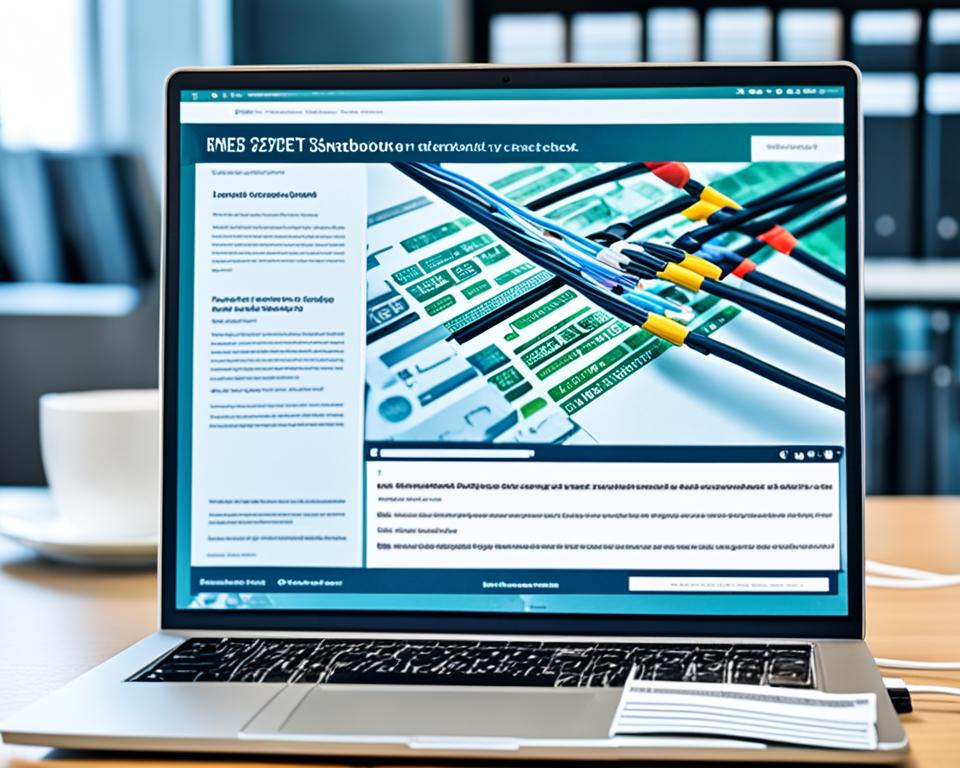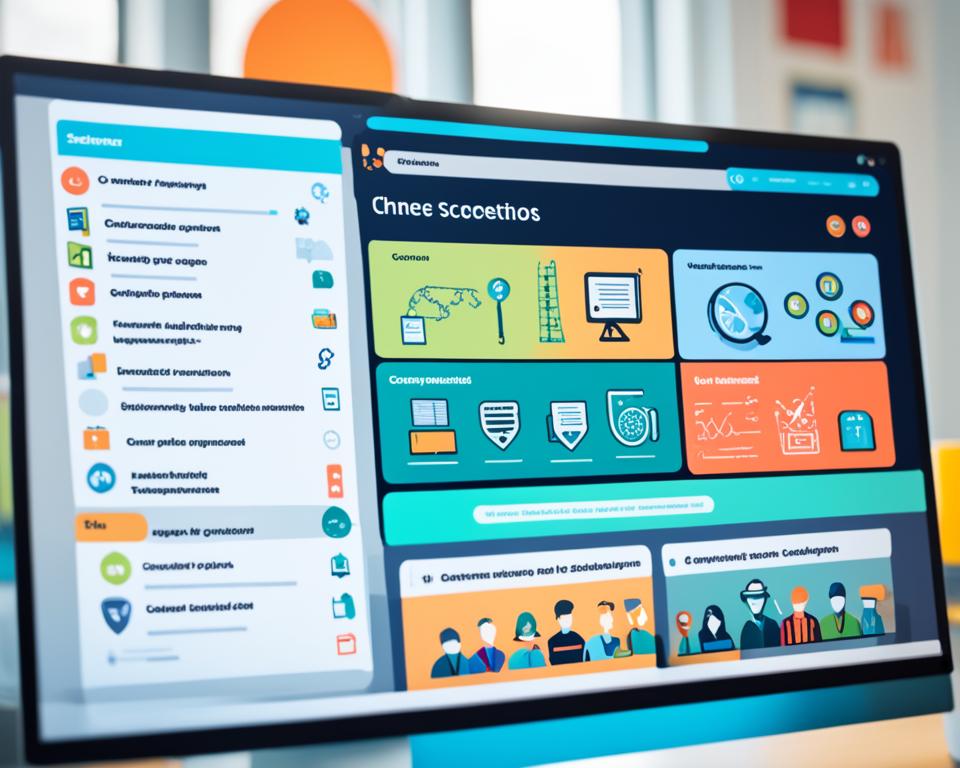Transitioning traditional course content to an online format is a process that requires careful planning and consideration. With the increasing popularity of online learning platforms, educators have the opportunity to adapt their curriculum for online delivery, providing students with a flexible and accessible learning experience. This article will explore effective strategies and considerations for converting traditional courses into an online format, ensuring a seamless transition for both students and instructors.
Key Takeaways:
- Transitioning traditional course content to an online format requires careful planning and consideration.
- Online learning platforms can provide the necessary tools and resources for converting traditional courses into online courses.
- Educators should approach online teaching with a deliberate and intentional mindset, focusing on learner-centered practices and inclusive strategies.
- Reimagining assessments and redefining classroom community are essential for creating engaging online learning experiences.
- Selecting the right technology and digital tools is crucial for effective online teaching and learning.
An Intentional Approach to Teaching Online
Transitioning from in-person teaching to online instruction requires more than simply transferring content from a traditional classroom setting. It calls for educators to adopt an intentional approach that involves redesigning course materials, rethinking learning experiences, and integrating technology purposefully. By shifting the focus towards learner-centered and inclusive practices, educators can create an engaging and effective online learning environment.
“Teaching online involves more than just transferring content from a traditional classroom setting. It requires a deliberate approach that involves redesigning course materials, rethinking learning experiences, and integrating technology intentionally.”
Adapting traditional curriculum for online learning necessitates a thoughtful examination of how content can be reimagined in a virtual format. It calls for a shift in pedagogical strategies that prioritize active learning and student engagement. By applying an intentional approach, educators can transform their teaching practices to meet the unique demands of online instruction.
“Adapting traditional curriculum for online learning necessitates a thoughtful examination of how content can be reimagined in a virtual format.”
Integrating technology purposefully is crucial in teaching online. Educators must identify and leverage digital tools that enhance the learning experience and facilitate communication and collaboration. The careful selection and implementation of these tools contribute to creating an interactive and dynamic virtual classroom environment.
By infusing learner-centered and inclusive practices into online teaching, educators can prioritize individual student needs and create an inclusive learning environment. This involves adopting strategies such as asynchronous and synchronous communication, providing multiple pathways for accessing course materials, and ensuring accessibility for all learners.
Seizing New Opportunities for Online Instruction
Transitioning to online instruction offers unique opportunities for educators to innovate and adapt their teaching methodologies. By intentionally redesigning course materials, rethinking learning experiences, and embracing technology, educators can create a dynamic and engaging online learning environment that effectively supports student success.
Plan for Online From the Beginning
When embarking on the journey of online course development, it is crucial for educators to plan from the very beginning. By taking the time to carefully consider the transition of classroom materials to an online format, educators can ensure a successful and engaging learning experience for their students.
One of the first steps in planning for online course development is to revisit the course goals. This involves reflecting on the desired learning outcomes and determining how they can be achieved in an online setting. By aligning the goals of the course with the capabilities and limitations of online learning, educators can make informed decisions about which aspects of the curriculum are most suitable for conversion.
Another important aspect of planning is considering the use of online materials and resources. Educators should explore the wide range of digital resources available, such as e-books, interactive multimedia, and online simulations. By incorporating these resources into the online course, educators can enhance the learning experience and provide students with a wealth of valuable content.
Additionally, educators should carefully structure the online learning experience to cater to the needs and expectations of online learners. This may involve breaking down the course into manageable modules or units, ensuring that each component of the curriculum is clearly organized and easily accessible. By providing a clear and logical structure, educators can help students navigate the online course effectively.
To support the planning process, educators should also consider the support available to them. This may include seeking guidance from instructional designers, technology specialists, or online learning communities. By tapping into these resources, educators can gain valuable insights and best practices that can inform their online course development.
By starting the planning process early and considering the needs of online learners, educators can convert classroom materials to an online format successfully. With careful planning and intentional decision-making, educators can create an engaging and effective online learning experience for their students.

|
Benefits of Planning for Online Course Development: |
Challenges of Planning for Online Course Development: |
|---|---|
|
|
Review Your Existing Syllabus
When transitioning your traditional course to an online format, it is crucial to review and adapt your existing syllabus. By revisiting your syllabus, you can ensure that it aligns with the needs and expectations of online learners. To successfully adapt your syllabus for the online format, follow these key steps:
1. Consider the Learning Goals
Begin by carefully considering the learning goals of your course and how they can be achieved in an online setting. Think about how you can modify your existing content to foster the same level of learning outcomes through online delivery. This may involve redesigning assignments, assessments, and activities to fit the online learning environment.
2. Evaluate Content and Structure
Next, evaluate the content and structure of your syllabus. Determine if any adjustments need to be made to accommodate online learning. Take into account the limitations and opportunities presented by the online format and make necessary revisions to ensure a seamless transition. Consider breaking down your content into smaller units to facilitate asynchronous learning and create a clear roadmap for online instruction.
3. Incorporate Online Resources
Explore and incorporate relevant online resources and tools that can enhance the learning experience for your students. This may include utilizing educational websites, interactive multimedia, and online platforms. By integrating technology into your syllabus, you can engage students in new and exciting ways, encouraging active participation and collaboration.
4. Communicate Expectations Clearly
One of the keys to successful online instruction is clear communication. Make sure that your syllabus clearly communicates your expectations, guidelines, and policies for the online course. Provide detailed instructions on how students should navigate the online platform and access course materials. Establish a communication plan that includes regular updates and avenues for students to ask questions and seek clarification.
5. Ensure Accessibility
Consider the accessibility of your syllabus and course materials for all students. Ensure that any text, videos, or other resources are accessible to those with disabilities. Provide alternative formats for materials if needed and make sure that your online learning platform is compatible with assistive technologies. By prioritizing accessibility, you can create an inclusive learning environment for all students.
By reviewing and adapting your existing syllabus for the online format, you can ensure that your course meets the needs of online learners and facilitates a seamless transition from traditional classroom instruction. Remember to continually evaluate and refine your syllabus as you gain more experience with online teaching.
Rethink the Structure and Content of Your Course
Transitioning to an online format requires a fundamental reimagining of the structure and content of your course. To ensure an engaging and effective online learning experience, educators must adapt their course materials to suit the unique dynamics of online delivery. This involves breaking down standards and objectives into smaller, more digestible units, determining which skills can be taught asynchronously and synchronously, and creating a segmented model for instruction. By reconfiguring course materials and leveraging technology, educators can create a cohesive and interactive online learning environment.
Breaking Down Standards and Objectives
When transitioning to online delivery, it is essential to break down the standards and objectives of your course into smaller, manageable units. This allows students to focus on specific concepts at a time and promotes a deeper understanding of the material. By breaking down the content, educators can design modules or lessons that align with the learning outcomes, making it easier for students to navigate and comprehend the course material.
Determining Asynchronous and Synchronous Learning
Online courses often provide flexibility in terms of when and where students can learn. As an educator, it is crucial to determine which skills can be effectively taught asynchronously, allowing students to access and engage with the content on their own time. On the other hand, certain activities or discussions may benefit from synchronous learning, fostering real-time collaboration and interaction among students. By striking a balance between asynchronous and synchronous learning, educators can offer a dynamic and engaging online learning experience.
Creating a Segmented Model for Instruction
One effective approach to online course design is creating a segmented model for instruction. This involves organizing the course content into modules or sections, each focusing on a specific topic or concept. By structuring the course in this way, educators can provide clear pathways for students to progress through the material and easily locate relevant resources. Additionally, a segmented model allows for ongoing assessment and feedback, ensuring students stay on track and can measure their progress.

Integrating Technology for Enhanced Learning
One of the key advantages of transitioning to an online format is the ability to leverage technology in the learning process. Educators should explore different online tools and platforms that can enhance the delivery of course content and engage students in interactive learning experiences. This may include utilizing multimedia resources, incorporating discussion boards or collaborative documents, and implementing interactive quizzes or assessments. By harnessing the power of technology, educators can create a dynamic and immersive learning environment that fosters student engagement and promotes deeper learning.
| Traditional Course Format | Reconfigured Online Course Format |
|---|---|
| Lecture-based delivery | Multimedia-rich content, including videos, interactive presentations, and online resources |
| In-person discussions | Online discussion forums, video conferences, and collaborative projects |
| Written assignments | Interactive assignments, online quizzes, and digital portfolios |
| Pre-determined class schedule | Flexible learning opportunities with asynchronous and synchronous components |
By rethinking the structure and content of their courses, educators can successfully adapt their traditional materials for online delivery. Through thoughtful planning, intentional use of technology, and the creation of engaging learning experiences, educators can ensure that their online courses are effective, interactive, and meaningful for students.
Reimagine Your Assessments
Assessments play a crucial role in online learning. As educators transition their courses to an online format, it is important to rethink and redesign assessments that align with this new format. By adapting assessments for the online environment, educators can effectively measure student progress and promote meaningful learning experiences.
One way to adapt assessments for online format is to utilize different types of assessments. Online quizzes can be used to test knowledge and understanding, while projects and discussions can assess critical thinking and communication skills. By diversifying the assessment methods, educators can cater to different learning styles and enhance student engagement.
Additionally, providing clear instructions and guidelines for online assessments is key to ensuring students understand what is expected of them. Clearly outlining the assessment criteria, submission process, and deadlines can help students navigate the online assessment process successfully.
“Adapting assessments for the online environment allows educators to accurately evaluate students’ learning outcomes and provide meaningful feedback for improvement.”
Reimagining assessments for the online format goes beyond simply transferring traditional assessment methods to a digital setting. Educators have the opportunity to leverage technology and incorporate innovative strategies to assess student learning. For example, online platforms can be used to facilitate real-time feedback during assessments or enable collaborative assessments where students work together remotely.
Benefits of Reimagining Assessments for Online Learning
When educators adapt assessments for online format, they unlock several benefits:
- Flexibility: Online assessments can be completed remotely, allowing flexibility for students to manage their time effectively.
- Improved accessibility: Online assessments can be designed to accommodate diverse student needs, including those with disabilities.
- Enhanced engagement: Digital tools and multimedia elements can be integrated into assessments to make them more interactive and engaging for students.
- Efficient grading: Online assessments can be automatically graded, saving educators time and providing instant feedback for students.
By reimagining assessments, educators can create a dynamic and effective online learning environment that promotes student success and mastery of course content.
Redefine Classroom Community and Student Engagement for Online
Online learning can sometimes feel isolating for students. In order to address this challenge, educators need to redefine how classroom community and student engagement are fostered in an online environment. Building a strong sense of community and promoting student engagement are crucial for effective online learning experiences.
Creating opportunities for virtual interactions is a key strategy in building a virtual classroom community. Educators can use discussion boards, chat features, and video conferencing platforms to facilitate communication and collaboration among students. These virtual interactions help to create a sense of belonging and connection, even in the absence of a physical classroom.
“The virtual classroom allows students to connect and interact with their peers and the instructor, fostering a sense of community and shared learning.”
Encouraging collaboration and discussion is another important aspect of fostering student engagement in online learning. Educators can assign group projects, facilitate online discussions, and use collaborative tools and platforms to encourage students to work together. By engaging in collaborative activities, students have the opportunity to learn from their peers, share ideas, and develop important teamwork skills.
Leveraging technology is a valuable strategy for facilitating student engagement in online learning. Educators can use interactive multimedia, simulations, and gamified elements to make the learning experience more engaging and interactive. By incorporating these technological tools into their online instruction, educators can cater to diverse learning styles and capture students’ attention and interest.
Benefits of Building a Virtual Classroom Community and Promoting Student Engagement in Online Learning:
- Enhanced student motivation and participation
- Increased peer-to-peer interaction and collaboration
- Improved understanding and retention of course materials
- Reduced feelings of isolation and increased sense of belonging
- Opportunities for students to practice essential communication and teamwork skills
By redefining how classroom community and student engagement are fostered in an online environment, educators can create a supportive and engaging online learning environment. This not only enhances student learning outcomes but also contributes to the overall success and satisfaction of the online learning experience.

Select Technology and Digital Tools Based on Online Teaching and Learning Needs
In order to effectively teach and facilitate online learning, educators must carefully select the right technology and digital tools. These tools play a crucial role in creating an engaging and interactive virtual learning environment. When choosing online teaching tools and digital resources, educators should consider a variety of factors to ensure they align with their specific online teaching needs and goals.
One essential tool for online teaching is a reliable learning management system (LMS). An LMS provides a centralized platform for organizing course materials, managing assignments, and facilitating communication between instructors and students. Popular options include Canvas, Moodle, and Blackboard. These platforms offer features such as content management, grading systems, and discussion forums, enabling educators to effectively deliver and manage online courses.
Video conferencing tools are also vital for facilitating live virtual classes and interactive discussions. Platforms like Zoom, Microsoft Teams, and Google Meet provide educators with the ability to conduct real-time video conferences, share screens, and engage with students in a synchronous manner. These tools enhance student engagement and foster a sense of community in the online learning environment.
Additionally, interactive media can greatly enhance online learning experiences. Tools such as interactive presentations, simulations, and virtual labs enable educators to create immersive and interactive content that promotes active learning. Examples of interactive media tools include Prezi, Adobe Captivate, and Labster.
When selecting technology and digital tools, it is important to consider factors such as accessibility, usability, compatibility, affordability, and pedagogical value. Ensuring that the chosen tools are accessible to all students regardless of their abilities is crucial for creating an inclusive learning experience. Usability and compatibility play a significant role in ensuring that both educators and students can navigate and use the tools effectively. Affordability is also an important consideration, as some tools may require additional fees or subscriptions.
By leveraging technology effectively and selecting the right online teaching tools and digital resources, educators can enhance the online learning experience for their students. These tools enable instructors to provide engaging and interactive instruction, foster collaboration and communication, and deliver high-quality online education.
Comparison of Online Teaching Tools
| Tool | Features | Accessibility | Usability | Compatibility | Affordability |
|---|---|---|---|---|---|
| Canvas | Content management, grading systems, discussion forums | Accessible | User-friendly | Compatible with various devices and browsers | Subscription-based |
| Zoom | Video conferencing, screen sharing, interactive features | Accessible with closed captioning and screen reader support | Intuitive interface | Compatible with multiple platforms | Free and paid plans available |
| Prezi | Interactive presentations, multimedia integration | Accessible with screen reader support | User-friendly with drag-and-drop interface | Compatible with various devices and browsers | Free and paid plans available |
Resources and References
Transitioning traditional course content to an online format can be a challenging task for educators. Fortunately, there is a wealth of online teaching resources and references available to support this transition. These resources offer valuable guidance, strategies, and best practices for effective online teaching. By exploring these resources, educators can access the information and insights they need to enhance their online instruction.
Whether you’re looking for tips on designing engaging online activities, navigating learning management systems, or incorporating technology tools into your virtual classroom, these online teaching resources have got you covered. From trusted educational websites to professional development organizations, there are various platforms that curate and provide comprehensive resources specifically tailored for transitioning to online format.
“Online teaching resources are invaluable assets for educators who want to make a successful transition from traditional to online instruction. These resources offer practical advice, instructional strategies, and evidence-based approaches that can guide educators in creating engaging online learning experiences.”
Examples of online teaching resources include:
- Education websites like Edutopia, TeachThought, and eLearning Industry, which provide articles, blog posts, and case studies on effective online teaching practices.
- Educational technology platforms like Google for Education, Microsoft Education, and Canvas, which offer comprehensive guides and tutorials on using their tools for online instruction.
- Professional organizations and associations such as the Online Learning Consortium or the International Society for Technology in Education (ISTE), which provide research-backed resources, webinars, and conferences focused on online teaching.
- Open educational resources (OER) platforms like OpenStax and MERLOT, which offer free and openly licensed instructional materials that can be adapted for online use.
In addition to online teaching resources, educators can also benefit from referencing research articles, academic journals, and books that delve into the theories and best practices of online instruction. These references offer a deeper understanding of the principles and methodologies behind effective online teaching.
Key Takeaways:
When transitioning to online format, educators can rely on a range of online teaching resources and references to assist them throughout the process. These resources provide expert guidance, practical strategies, and evidence-based approaches that can enhance the quality of online instruction. By utilizing these resources, educators can effectively adapt their traditional course content for online delivery, creating engaging and meaningful learning experiences for their students.
Conclusion
As education moves online, educators must adapt their curriculum for online learning to ensure a seamless transition. By implementing careful planning, intentional technology integration, and learner-centered practices, educators can effectively deliver engaging and effective online learning experiences to their students.
Transitioning traditional course content to an online format requires thoughtful consideration. Educators should review and revise their existing syllabus, reconfigure course materials, and reimagine assessments to align with the online format. It is crucial to recreate classroom community and promote student engagement in the virtual environment to enhance the online learning experience.
Additionally, selecting the appropriate technology and digital tools is essential for effective online teaching and learning. Educators should choose tools that meet their specific teaching needs, focusing on factors such as accessibility, usability, compatibility, affordability, and pedagogical value. By leveraging technology effectively, educators can enhance the online learning experience for their students.
Overall, by following the strategies outlined in this article, educators can successfully transition their curriculum for online delivery, providing students with engaging, interactive, and effective online learning experiences. As education evolves, it is crucial for educators to adapt their teaching methodologies to meet the needs of the digital age.
FAQ
How can I transition my traditional course content to an online format?
Transitioning traditional course content to an online format requires careful planning and consideration. By following effective strategies, educators can adapt their curriculum for online delivery, ensuring a seamless transition for both students and instructors.
What is the best approach to teaching online?
Teaching online involves more than just transferring content from a traditional classroom setting. It requires a deliberate approach that involves redesigning course materials, rethinking learning experiences, and integrating technology intentionally. By shifting the focus towards learner-centered and inclusive practices, educators can create an engaging and effective online learning environment.
How should I plan for online course development?
Planning for online course development should start from the beginning. Educators should revisit their course goals, consider the use of online materials and resources, and determine the best way to structure the learning experience for students. By considering the needs and expectations of online learners and identifying the support available, educators can ensure a smooth transition from traditional classroom materials to an online format.
What should I consider when reviewing my existing syllabus for online delivery?
When transitioning to an online format, it is important to review and revise your existing syllabus. This includes considering the learning goals of your course and how they can be achieved in an online setting. By reevaluating the content and structure of your syllabus, you can ensure that it aligns with the needs and expectations of online learners.
How should I rethink the structure and content of my course for online delivery?
Transitioning to an online format requires rethinking the structure and content of your course. This includes breaking down standards and objectives into smaller units, determining which skills can be taught asynchronously and synchronously, and creating a segmented model for instruction. By reconfiguring course materials and leveraging technology, educators can create a cohesive and engaging online learning experience.
How should I reimagine my assessments for online learning?
Assessments play a crucial role in online learning. Educators need to rethink and redesign their assessments to align with the online format. This may involve using different types of assessments, such as online quizzes, projects, or discussions, and providing clear instructions and guidelines for students. By reimagining assessments, educators can effectively measure student progress and promote meaningful learning experiences.
How can I build classroom community and promote student engagement in an online learning environment?
Online learning can sometimes feel isolating for students. Educators need to redefine how classroom community and student engagement are fostered in an online environment. This includes creating opportunities for virtual interactions, encouraging collaboration and discussion, and leveraging technology to facilitate engagement. By building a strong sense of community, educators can enhance student engagement and create a supportive online learning environment.
What factors should I consider when selecting technology and digital tools for online teaching?
Choosing the right technology and digital tools is essential for effective online teaching and learning. Educators need to select tools that align with their online teaching needs, such as learning management systems, video conferencing tools, and interactive media. It is important to consider factors such as accessibility, usability, compatibility, affordability, and pedagogical value when choosing these tools. By leveraging technology effectively, educators can enhance the online learning experience for students.
Are there resources and references available to support educators in transitioning to an online format?
Yes, there are numerous online teaching resources and references available to support educators in transitioning their traditional course content to an online format. These resources provide guidance, strategies, and best practices for effective online teaching. Educators can explore these resources to access valuable information and insights to enhance their online instruction.
What is the importance of transitioning education online and adapting curriculum for online learning?
Transitioning traditional course content to an online format requires careful planning, intentional integration of technology, and a focus on learner-centered practices. By following the strategies outlined in this article, educators can successfully transition their curriculum for online delivery and provide engaging and effective online learning experiences for their students.





